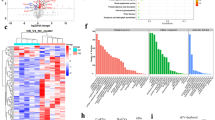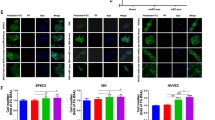Abstract
Purpose
Obesity has been linked to a higher risk of postmenopausal breast cancer Yet, research indicates an opposite correlation between obesity and premenopausal breast cancer risk. Various obesity phenotypes based on metabolic health could play a significant part. This study aims to assess how plasma exosomes taken from women with varying obesity phenotypes impact MCF-7 cell migration, matrix metalloproteinase-2 activity, and apoptosis.
Methods
The characterization of isolated exosomes and their internalization into MCF-7 cells was evaluated. The treatment of MCF-7 cells with exosomes isolated from different groups was done. Migration, the activity of MMP-2, mRNA expression of Bax and Bcl-2, protein expression of p-53 and Thr55 p-p53, and apoptosis were assessed.
Results
Isolated exosomes from unhealthy obese individuals increase MCF-7 cell migration. Regarding MMP activities, unhealthy normal weight and overweight and healthy obese groups isolated exosomes increase the MMP-2 activity than the treated group with exosomes isolated from counterpart groups. Furthermore, unhealthy normal weight and overweight and healthy obese obtained exosomes decrease apoptosis compared to counterpart groups.
Conclusion
Altogether, plasma exosomes derived from both unhealthy individuals with normal weight and overweight status, as well as those with unhealthy obesity, negatively impacted the behavior of estrogen/progesterone receptor-positive breast cancer cells.





Similar content being viewed by others
Data Availability
Data are available from the authors upon reasonable request and with permission of the corresponding author.
References
La Camera G, Gelsomino L, Malivindi R, Barone I, Panza S, De Rose D, et al. Adipocyte-derived extracellular vesicles promote breast cancer cell malignancy through HIF-1α activity. Cancer Lett. 2021;521:155–68.
Nagrani R, Mhatre S, Rajaraman P, Soerjomataram I, Boffetta P, Gupta S, et al. Central obesity increases risk of breast cancer irrespective of menopausal and hormonal receptor status in women of south asian ethnicity. Eur J Cancer. 2016;66:153–61.
Cotterchio M, Kreiger N, Theis B, Sloan M, Bahl S. Hormonal factors and the risk of breast cancer according to estrogen-and progesterone-receptor subgroup. Cancer Epidemiol Biomarkers Prev. 2003;12(10):1053–60.
White AJ, Nichols HB, Bradshaw PT, Sandler DP. Overall and central adiposity and breast cancer risk in the Sister Study. Cancer. 2015;121(20):3700–8.
Tsang J, Tse GM. Molecular classification of breast cancer. Adv Anat Pathol. 2020;27(1):27–35.
Suzuki R, Saji S, Toi M. Impact of body mass index on breast cancer in accordance with the life-stage of women. Front Oncol. 2012;2:123.
Klein S, Wadden T, Sugerman HJ. AGA technical review on obesity. Gastroenterology. 2002;123(3):882–932.
Wang B, Zhang M, Wang S, Wang C, Wang J, Li L, et al. Dynamic status of metabolically healthy overweight/obesity and metabolically unhealthy and normal weight and the risk of type 2 diabetes mellitus: a cohort study of a rural adult chinese population. Obes Res Clin Pract. 2018;12(1):61–71.
Park YMM, White AJ, Nichols HB, O’Brien KM, Weinberg CR, Sandler DP. The association between metabolic health, obesity phenotype and the risk of breast cancer. Int J Cancer. 2017;140(12):2657–66.
Kabat GC, Kim MY, Lee JS, Ho GY, Going SB, Beebe-Dimmer J, et al. Metabolic obesity phenotypes and risk of breast Cancer in postmenopausal WomenMetabolic obesity phenotypes and breast Cancer. Cancer Epidemiol Biomarkers Prev. 2017;26(12):1730–5.
Guo W, Gao Y, Li N, Shao F, Wang C, Wang P, et al. Exosomes: New players in cancer. Oncol Rep. 2017;38(2):665–75.
Reza AMMT, Choi Y-J, Yasuda H, Kim J-H. Human adipose mesenchymal stem cell-derived exosomal-miRNAs are critical factors for inducing anti-proliferation signalling to A2780 and SKOV-3 ovarian cancer cells. Sci Rep. 2016;6(1):1–15.
Milman N, Ginini L, Gil Z. Exosomes and their role in tumorigenesis and anticancer drug resistance. Drug Resist Updates. 2019;45:1–12.
Giordano C, La Camera G, Gelsomino L, Barone I, Bonofiglio D, Andò S, et al. The biology of exosomes in breast cancer progression: dissemination, immune evasion and metastatic colonization. Cancers. 2020;12(8):2179.
La Camera G, Gelsomino L, Caruso A, Panza S, Barone I, Bonofiglio D, et al. The emerging role of extracellular vesicles in endocrine resistant breast cancer. Cancers. 2021;13(5):1160.
Clement E, Lazar I, Attané C, Carrié L, Dauvillier S, Ducoux-Petit M, et al. Adipocyte extracellular vesicles carry enzymes and fatty acids that stimulate mitochondrial metabolism and remodeling in tumor cells. EMBO J. 2020;39(3):e102525.
Lazar I, Clement E, Dauvillier S, Milhas D, Ducoux-Petit M, LeGonidec S, et al. Adipocyte exosomes promote Melanoma aggressiveness through fatty acid oxidation: a novel mechanism linking obesity and CancerAdipocyte exosomes: a new link between obesity and Cancer. Cancer Res. 2016;76(14):4051–7.
Wang J, Wu Y, Guo J, Fei X, Yu L, Ma S. Adipocyte-derived exosomes promote lung cancer metastasis by increasing MMP9 activity via transferring MMP3 to lung cancer cells. Oncotarget. 2017;8(47):81880.
Lin R, Wang S, Zhao RC. Exosomes from human adipose-derived mesenchymal stem cells promote migration through wnt signaling pathway in a breast cancer cell model. Mol Cell Biochem. 2013;383:13–20.
Wang S, Su X, Xu M, **ao X, Li X, Li H, et al. Exosomes secreted by mesenchymal stromal/stem cell-derived adipocytes promote breast cancer cell growth via activation of Hippo signaling pathway. Stem Cell Res Ther. 2019;10:1–12.
Ramos-Andrade I, Moraes J, Brandão-Costa RM, da Silva SV, de Souza A, da Silva C, et al. Obese adipose tissue extracellular vesicles raise breast cancer cell malignancy. Endocrine-related Cancer. 2020;27(10):571–82.
Jafari N, Llevenes P, Denis GV. Exosomes as novel biomarkers in metabolic disease and obesity-related cancers. Nat Reviews Endocrinol. 2022;18(6):327–8.
Khalyfa A, Masa JF, Qiao Z, González M, Marti S, Khalyfa AA et al. Plasma exosomes in obesity hypoventilation syndrome patients drive lung cancer cell malignant properties: Effect of long-term adherent CPAP treatment. Biochimica et Biophysica Acta (BBA)-Molecular basis of Disease. 2022;1868(10):166479.
Sadegh-Nejadi S, Afrisham R, Emamgholipour S, Izadi P, Eivazi N, Tahbazlahafi B, et al. Influence of plasma circulating exosomes obtained from obese women on tumorigenesis and tamoxifen resistance in MCF‐7 cells. IUBMB Life. 2020;72(9):1930–40.
Ellis KJ, Bell SJ, Chertow GM, Chumlea WC, Knox TA, Kotler DP et al. Bioelectrical impedance methods in clinical research: a follow-up to the NIH Technology Assessment Conference. Nutrition. 1999;15(11–12):874 – 80.
Consultation W. Obesity: preventing and managing the global epidemic. Volume 894. World Health Organization technical report series; 2000. pp. 1–253.
Wildman RP, Muntner P, Reynolds K, McGinn AP, Rajpathak S, Wylie-Rosett J, et al. The obese without cardiometabolic risk factor clustering and the normal weight with cardiometabolic risk factor clustering: prevalence and correlates of 2 phenotypes among the US population (NHANES 1999–2004). Arch Intern Med. 2008;168(15):1617–24.
Tohidi M, Ghasemi A, Hadaegh F, Derakhshan A, Chary A, Azizi F. Age-and sex-specific reference values for fasting serum insulin levels and insulin resistance/sensitivity indices in healthy iranian adults: Tehran lipid and glucose study. Clin Biochem. 2014;47(6):432–8.
Théry C, Amigorena S, Raposo G, Clayton A. Isolation and characterization of exosomes from cell culture supernatants and biological fluids. Curr Protocols cell Biology. 2006;30(1):3. 1–3. 9.
Van den Brandt PA, Spiegelman D, Yaun S-S, Adami H-O, Beeson L, Folsom AR, et al. Pooled analysis of prospective cohort studies on height, weight, and breast cancer risk. Am J Epidemiol. 2000;152(6):514–27.
Morimoto LM, White E, Chen Z, Chlebowski RT, Hays J, Kuller L, et al. Obesity, body size, and risk of postmenopausal breast cancer: the Women’s Health Initiative (United States). Cancer Causes Control. 2002;13:741–51.
Lahmann PH, Hoffmann K, Allen N, Van Gils CH, Khaw KT, Tehard B, et al. Body size and breast cancer risk: findings from the european prospective investigation into Cancer and Nutrition (EPIC). Int J Cancer. 2004;111(5):762–71.
Neuhouser ML, Aragaki AK, Prentice RL, Manson JE, Chlebowski R, Carty CL, et al. Overweight, obesity, and postmenopausal invasive breast cancer risk: a secondary analysis of the women’s health initiative randomized clinical trials. JAMA Oncol. 2015;1(5):611–21.
Wu Q, Li B, Li Z, Li J, Sun S, Sun S. Cancer-associated adipocytes: Key players in breast cancer progression. J Hematol Oncol. 2019;12:1–15.
Yang H, Liang J, Zhou J, Mi J, Ma K, Fan Y, et al. Knockdown of RHOC by shRNA suppresses invasion and migration of cholangiocellular carcinoma cells via inhibition of MMP2, MMP3, MMP9 and epithelial-mesenchymal transition. Mol Med Rep. 2016;13(6):5255–61.
Radisky ES, Radisky DC. Matrix metalloproteinases as breast cancer drivers and therapeutic targets. Front Biosci (Landmark Ed). 2015;20(7):1144–63.
Allott EH, Lysaght J, Cathcart MC, Donohoe CL, Cummins R, McGarrigle SA, et al. MMP9 expression in oesophageal adenocarcinoma is upregulated with visceral obesity and is associated with poor tumour differentiation. Mol Carcinog. 2013;52(2):144–54.
Reggiani F, Labanca V, Mancuso P, Rabascio C, Talarico G, Orecchioni S, et al. Adipose progenitor cell secretion of GM-CSF and MMP9 promotes a stromal and immunological microenvironment that supports breast cancer progression. Cancer Res. 2017;77(18):5169–82.
Boumiza S, Chahed K, Tabka Z, Jacob M-P, Norel X, Ozen G. MMPs and TIMPs levels are correlated with anthropometric parameters, blood pressure, and endothelial function in obesity. Sci Rep. 2021;11(1):20052.
Cui H, Schroering A, Ding H-F. p53 mediates DNA damaging drug-induced apoptosis through a caspase-9-dependent pathway in SH-SY5Y neuroblastoma cells. Mol Cancer Ther. 2002;1(9):679–86.
Schuler M, Green D. Mechanisms of p53-dependent apoptosis. Biochem Soc Trans. 2001;29(6):684–8.
Brunelle JK, Letai A. Control of mitochondrial apoptosis by the Bcl-2 family. J Cell Sci. 2009;122(4):437–41.
Juin P, Hunt A, Littlewood T, Griffiths B, Swigart LB, Korsmeyer S, et al. c-Myc functionally cooperates with bax to induce apoptosis. Mol Cell Biol. 2002;22(17):6158–69.
Li HH, Li AG, Sheppard HM, Liu X. Phosphorylation on Thr-55 by TAF1 mediates degradation of p53: a role for TAF1 in cell G1 progression. Mol Cell. 2004;13(6):867–78.
Fallahian F, Aghaei M, Abdolmohammadi MH, Hamzeloo-Moghadam M. Molecular mechanism of apoptosis induction by Gaillardin, a sesquiterpene lactone, in breast cancer cell lines: Gaillardin-induced apoptosis in breast cancer cell lines. Cell Biol Toxicol. 2015;31:295–305.
Norouzirad R, González-Muniesa P, Ghasemi A. Hypoxia in obesity and diabetes: potential therapeutic effects of hyperoxia and nitrate. Oxidative medicine and cellular longevity. 2017;2017.
Chiu T-L, Su C-C. Curcumin inhibits proliferation and migration by increasing the bax to Bcl-2 ratio and decreasing NF-κBp65 expression in breast cancer MDA-MB-231 cells. Int J Mol Med. 2009;23(4):469–75.
Funding
The present paper is derived from a Ph.D. thesis with no. 1401236855642 which received support from the Tehran University of Medical Sciences, Tehran, Iran.
Author information
Authors and Affiliations
Contributions
FE performed experimental tests. FE, MP, and SE participated in the study design, interpreted results, and wrote the draft of the manuscript. MA and HZM conducted sample collection. MP and SE critically revised and edited the manuscript. SS helped with methodology and statistical analysis. All authors read and approved the final manuscript.
Corresponding authors
Ethics declarations
Ethics approval and consent to participate
The study protocol has been approved by the ethics committee of Tehran University of Medical Sciences (TUMS) with the following identification: IR. TUMS.MEDICINE. REC.1400.106). Every participant received comprehensive information regarding the study protocol and willingly provided written informed consent before their inclusion in the study.
Conflict of interest
The authors declare that they have no conflict of interest.
Additional information
Publisher’s Note
Springer Nature remains neutral with regard to jurisdictional claims in published maps and institutional affiliations.
Electronic supplementary material
Below is the link to the electronic supplementary material.
Rights and permissions
Springer Nature or its licensor (e.g. a society or other partner) holds exclusive rights to this article under a publishing agreement with the author(s) or other rightsholder(s); author self-archiving of the accepted manuscript version of this article is solely governed by the terms of such publishing agreement and applicable law.
About this article
Cite this article
Esmaeili, F., Abolhasani, M., Zabihi-Mahmoudabadi, H. et al. Exosomes isolated from metabolically unhealthy normal weight and overweight phenotypes deteriorate the ER/PR positive breast cancer behavior. J Diabetes Metab Disord 23, 533–544 (2024). https://doi.org/10.1007/s40200-023-01295-1
Received:
Accepted:
Published:
Issue Date:
DOI: https://doi.org/10.1007/s40200-023-01295-1




